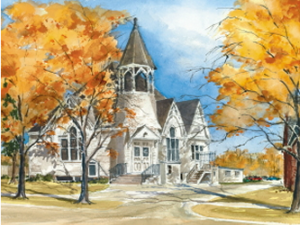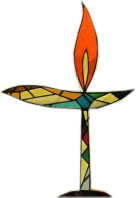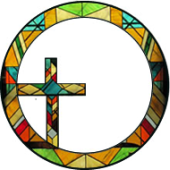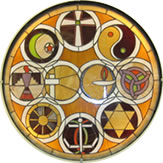About the Unitarian Universalists of Stockton, IL

Founded in 1899 as a beacon of religious freedom and equality, our congregation continues to be a welcoming place for all religious seekers. We are united not by a specific belief system or concept of God, but by the mutual yearning for spiritual community that helps us all on our quest for truth and meaning.
Informed by our connection to two historic faiths- Unitarianism, the belief in one God- and Universalism, the belief that all people are deserving of God's love and salvation, the Unitarian Universalist Church of Stockton affirms that all are deserving of and beholden to the Spirit of Love.
Our members and friends come from a wide array of backgrounds, opinions, religious ideas and political affiliations making for healthy and worthwhile dialogue about issues important to us all. We welcome different perspectives as we believe what each of us knows about the world is a piece of the whole, and we are united by the strong belief that we need not think alike to love alike.
Won't you come and visit us for a service or event? We'd love to hear your story.
Informed by our connection to two historic faiths- Unitarianism, the belief in one God- and Universalism, the belief that all people are deserving of God's love and salvation, the Unitarian Universalist Church of Stockton affirms that all are deserving of and beholden to the Spirit of Love.
Our members and friends come from a wide array of backgrounds, opinions, religious ideas and political affiliations making for healthy and worthwhile dialogue about issues important to us all. We welcome different perspectives as we believe what each of us knows about the world is a piece of the whole, and we are united by the strong belief that we need not think alike to love alike.
Won't you come and visit us for a service or event? We'd love to hear your story.
Who We Are:
|
There are seven principles which Unitarian Universalist congregations affirm and promote:
|
Who We Are:
|
Unitarian Universalism (UU) draws from many sources:
|
Our Symbols

The Flaming Chalice: Symbol of Our UU Faith
A flame within a chalice (a cup with a stem and foot), represents the Unitarian Universalist Association (UUA) and is a symbol of the Unitarian Universalist faith.
"At the opening of Unitarian Universalist worship services, many congregations light a flame inside a chalice. This flaming chalice has become a well-known symbol of our denomination. It unites our members in worship and symbolizes the spirit of our work."
—Dan Hotchkiss
Hans Deutsch, an Austrian artist, first brought together the chalice and the flame as a Unitarian symbol during his work with the Unitarian Service Committee during World War II. To Deutsch, the image had connotations of sacrifice and love. Unitarian Universalists today have many different interpretations of the image. To learn more about the history of our Unitarian Universalist symbol, please read the pamphlet, "The Flaming Chalice."
The flaming chalice image has changed many times over the past 65 years. Modern chalice designs often incorporate two overlapping circles which, for many people, represent our Unitarian and Universalist heritages.
A flame within a chalice (a cup with a stem and foot), represents the Unitarian Universalist Association (UUA) and is a symbol of the Unitarian Universalist faith.
"At the opening of Unitarian Universalist worship services, many congregations light a flame inside a chalice. This flaming chalice has become a well-known symbol of our denomination. It unites our members in worship and symbolizes the spirit of our work."
—Dan Hotchkiss
Hans Deutsch, an Austrian artist, first brought together the chalice and the flame as a Unitarian symbol during his work with the Unitarian Service Committee during World War II. To Deutsch, the image had connotations of sacrifice and love. Unitarian Universalists today have many different interpretations of the image. To learn more about the history of our Unitarian Universalist symbol, please read the pamphlet, "The Flaming Chalice."
The flaming chalice image has changed many times over the past 65 years. Modern chalice designs often incorporate two overlapping circles which, for many people, represent our Unitarian and Universalist heritages.

The Universalist Cross
In 1805, Universalist theologian, minister and educator Hosea Ballou published A Treatise on Atonement in which he argued that God loved all of humanity and that none of us was eternally damned. This understanding of "Universal Grace" has been a central theological component of Universalism ever since. The Universalist Cross (also called the Humiliati Cross after its designers, the Humiliati group of Universalist seminarians at the Crane School of Theology at Tufts University) symbol reflects the fact that all humanity, and not just Christians, are subject to the love and forgiveness of God. The Christian cross is taken from the center of the universal circle and placed at the bottom left in order to leave room for other legitimate paths towards God.
As a Universalist church, the UU Church of Stockton maintains strong emotional and theological ties to Ballou's theory of Universal Grace and the Universalist Cross can be seen several places in our church home.
In 1805, Universalist theologian, minister and educator Hosea Ballou published A Treatise on Atonement in which he argued that God loved all of humanity and that none of us was eternally damned. This understanding of "Universal Grace" has been a central theological component of Universalism ever since. The Universalist Cross (also called the Humiliati Cross after its designers, the Humiliati group of Universalist seminarians at the Crane School of Theology at Tufts University) symbol reflects the fact that all humanity, and not just Christians, are subject to the love and forgiveness of God. The Christian cross is taken from the center of the universal circle and placed at the bottom left in order to leave room for other legitimate paths towards God.
As a Universalist church, the UU Church of Stockton maintains strong emotional and theological ties to Ballou's theory of Universal Grace and the Universalist Cross can be seen several places in our church home.

World Religious Symbols
Recognizing that no religion has a monopoly on the truth but that all traditions have something to teach us about the nature of Life and Love, we feature a collection of world relgious symbols at the heart of our sanctuary.
The Universalist Cross and the UU Flaming Chalice interlock side-by-side and are flanked by symbols representing (clockwise from the top) Christianity, Taoism, Wicca, Judaism, Sikhism, Buddhism, Native American spirituality and Islam.
Many thanks to UU Church of Stockton member Terry Lee for his beautiful stained glass art that graces our sanctuary and this web site.
Recognizing that no religion has a monopoly on the truth but that all traditions have something to teach us about the nature of Life and Love, we feature a collection of world relgious symbols at the heart of our sanctuary.
The Universalist Cross and the UU Flaming Chalice interlock side-by-side and are flanked by symbols representing (clockwise from the top) Christianity, Taoism, Wicca, Judaism, Sikhism, Buddhism, Native American spirituality and Islam.
Many thanks to UU Church of Stockton member Terry Lee for his beautiful stained glass art that graces our sanctuary and this web site.
